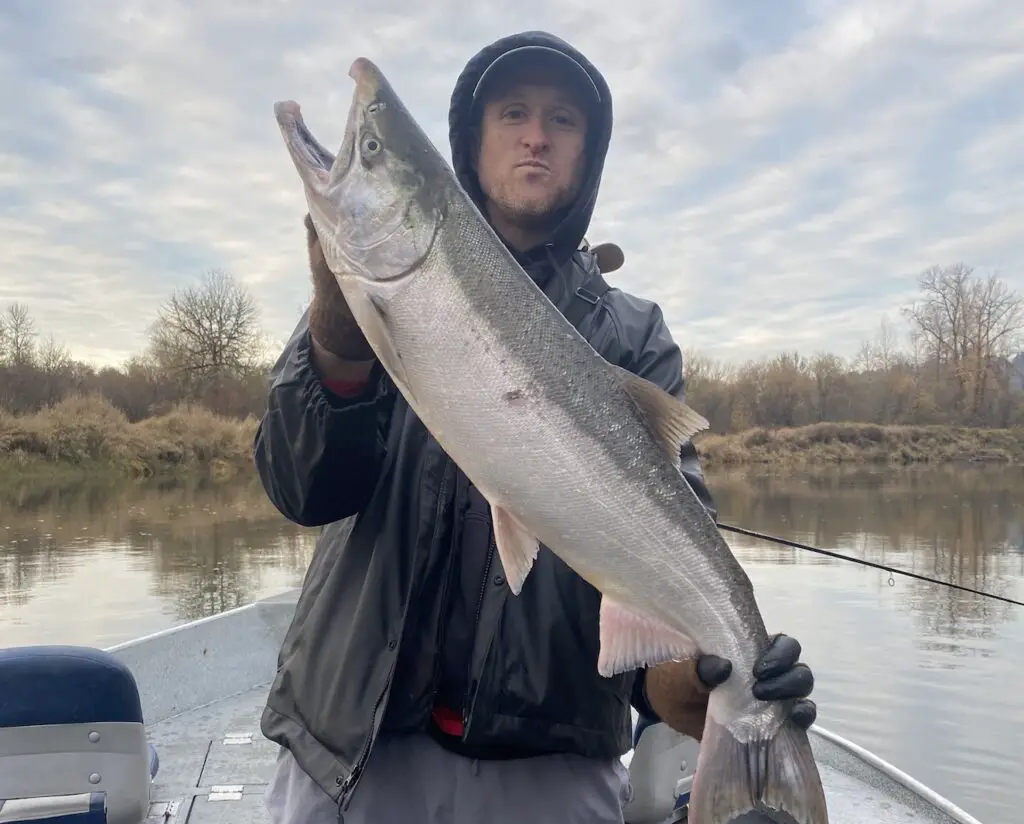
Before you dig in, I also have pages on key Chehalis River tributaries if you are more interested in those:
Chehalis River Salmon Fishing 2025
Fall salmon fishing on the Chehalis River is almost exclusively about coho salmon since that’s the primary species anglers hope to retain.
There will be chinook present, but generally not retainable most years. There will also be significant amounts of chum salmon, especially on the lower river, but most anglers just release these as the meat isn’t as sought after compared to coho.
Updated status on hatchery coho returning to the Chehalis River
Since I don’t have graphs for the mainstem Chehalis River hatchery return, I will show graphs of each tributary to help you keep tabs on the salmon return.



The above graphs will update every Thursday typically.
When to fish for coho on the Chehlias River?
Again, the below graphs are based on the returns to the Chehalis key tributaries: Wynoochee, Satsop, and Skookumchuck Rivers.
Wynoochee River

Satsop River

Skookumchuck River

While the best return is typically on the Satsop River, the Chehalis River mainstem is a great option to target, and the return timing more closely tracks that of the Skookumchuck River above.
I like to fish the Chehalis River for Coho in November for the most consistent success. As always, river flows based on how much rainfall drops in upper elevations often determine coho abundance timing.
Forecast for 2024 Chehalis River Coho
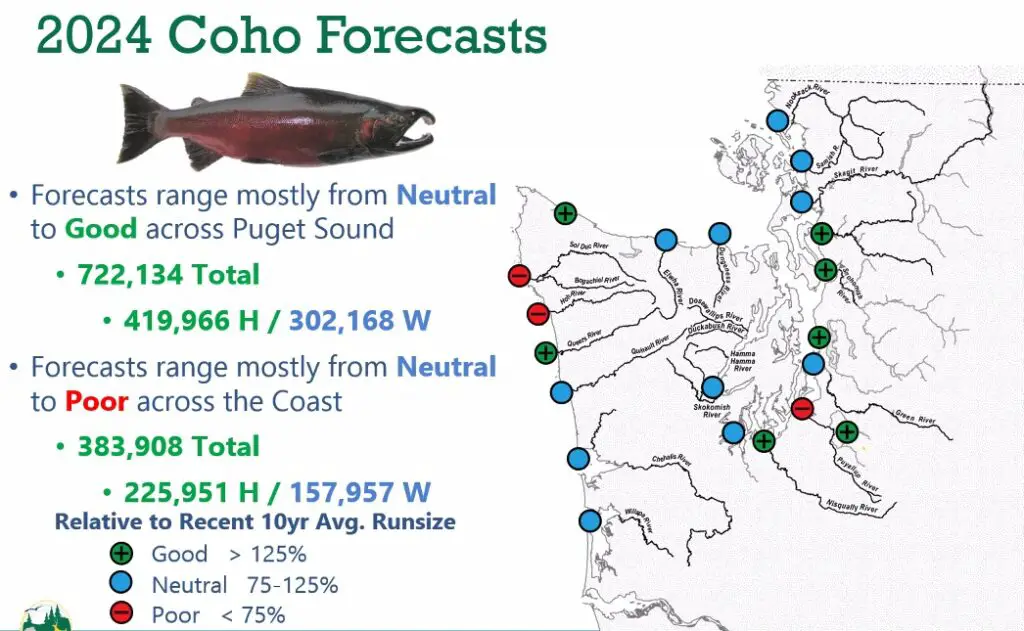
Coho stocks have been extremely strong throughout Grays Harbor the past two years, and 2024 is expected to be not quite as robust but still right around the ten-year average.
How to fish for Coho Salmon on the Chehalis River?
I have several important resources on PNWBestLife.com and the YouTube channel to help you become a better coho salmon angler.
There are two primary methods you should consider learning to maximize your coho fishing success:
- Spinner fishing
- Twitching jigs
If you want to learn more about river fishing for salmon in general, head over the aforementioned link. A key aspect of river fishing is learning to read water.
The Chehalis River has long runs of mostly gentle flowing water in many of the locations you will target for coho. Coho are often milling around in any of these softer flows and near underwater structures such as log jams and wood piles.
The key is to just cover enough water until you find a coho willing to bite. This requires confidence in the technique you are using, so you can keep moving and covering water if you’re not getting bit.
Once you do get bit, work that area, as there are often more coho present. You won’t always see coho rolling and giving away their position either, although that is certainly a helpful way to locate them.
Issues in determining salmon seasons during North of Falcon for the Chehalis River
For starters, I’m a newbie to this topic, and I’m using this section to give a greater voice to those who are being most impacted, that being the in-river sport fishing communities that do their salmon angling on Grays Harbor rivers, and more specifically the Chehalis River.
There’s an important document you need to be aware of called the Grays Harbor Management Plan. (GHMP)
It was an official policy of the WDFW Commission and it was in effect from the below dates:
| Effective Date: March 1, 2014 |
| Termination Date: December 31, 2023 |
That means it’s the document which should have guided the North of Falcon process in 2022-2023.
The GHMP is #1 about conservation, but also discusses equitable distribution between user groups such as marine sport fishing, tribal commercial, non-tribal commercial, and in-river sport fishing.
There are a few facts which should be known about the Chehalis River and chinook management that I will highlight here and you can come to your own conclusions about what’s going on.
I’m not going to speculate on the “behind the scenes bits” as I believe that would draw attention away from the simple facts on this topic which are paramount.
- The on-the-gravel goal for chinook in the Chehalis River is 9,754.
- The WDFW escapement estimate after all “approved fisheries” is 9,066 chinook
Why would we approve fisheries and harvest beyond the escapement goal?
The answer is that certain user groups have the ability to push harvest beyond management targets. This is clear even in the Puget Sound Chinook Management plan which is for ESA listed wild chinook.
These groups are outside the jurisdiction of WDFW. Here’s a few of them:
- State of Alaska – Sport and Commercial
- Nation of Canada – Sport and Commercial
- Treaty Indian Nations
We can write whatever policies we want to in our management plans and those groups are not necessarily bound to them. We bring some of these groups together in the Pacific Fisheries Management Council (PFMC) and others such as Treaty tribes in North of Falcon (NoF), but WDFW policies which don’t become legally binding for those other user groups don’t have much teeth.
I’m not aware of the legal specifics, but I’m not sure the management plan for Grays Harbor holds as much weight as the one for Puget Sound on local treaty tribes because in the case of Puget Sound, there’s a federal agency which requires the management plan for prosecuting fisheries on ESA listed chinook.
The bottom line is that the GHMP is a nice conservation first document, but adhering to it seems to be aspirational rather than binding, and that is a total shame given the dire need for sustainable fisheries up and down the Pacific coast.
If it was binding, there would be no in-river fishery at all not just a catch-and-release fishery, as we saw with the Skykomish River summer chinook, but we would at least (probably) on paper meet escapement objectives.
If you’re reading this far and think I’m calling out one particular group, that’s not my intention and let me be more fair in this case:
The chinook harvest of Chehalis River chinook is NOT all happening outside of GHMP jurisdiction. There’s still marine sport harvest, there’s non-treaty commercial and non-treaty Chehalis Tribe.
Why would we allow any non-treaty commercial harvest on a resource not meeting escapement goals?
Why would WDFW negotiate with the Quinault tribe for a treaty commercial harvest which takes us below escapement goals even if all other harvest / impact was eliminated?
From a Quinault perspective, marine sport and commercial harvest prior to the terminal run is 10x (Alaska and Canada especially) what they’re proposing to take. How is that equitable? Is this how they hold WDFW and the federal side more accountable for being a serious player in the PFMC?
Does the state and federal level need to be much more serious about addressing conservation for the next PFMC? Absolutely! There’s won’t be a resource to manage at the current rate of environmental, predator and harvest pressure being applied to chinook up and down the coast.
The bottom line is that the first group to get shutdown continues to be the in-river side, which tends to the most able to target only hatchery salmon, yet WDFW seems to make concessions to other commercial fishery user groups fully within the GHMP jurisdiction. And I haven’t even started on the coho side of the discussion yet, but know that it follows a similar story arc.
Or would you like to turn your attention to wild steelhead management on the coast and in the Chehalis River? More pain, indeed.
Feel free to correct any of the above in the comments below, I will happily amend if you provide solid contradictory information, as this is what I know right now from my sources and reading on the situation.
Chehalis River Winter Steelhead Fishing 2024-2025
The Chehalis River Winter Steelhead run offers the most abundance of hatchery steelhead near the population centers of Western Washington. With the almost complete lack of viable hatchery steelhead returning to Puget Sound rivers, the Chehalis tributaries have been elevated in importance and attention.
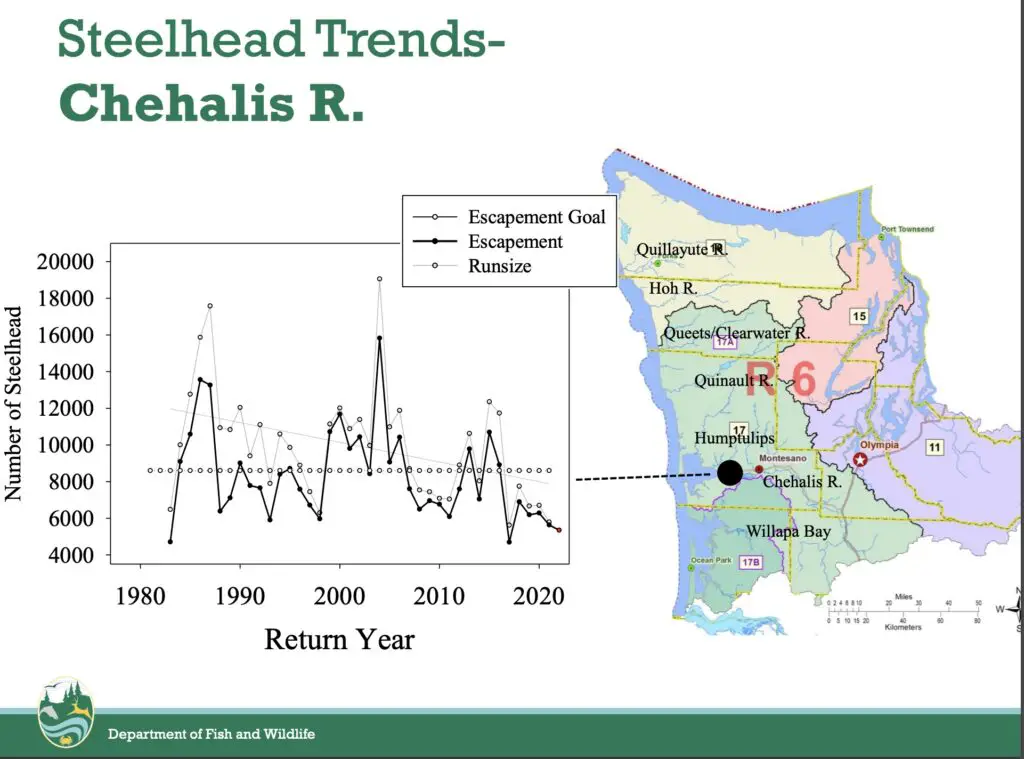
The increased focus on the Chehalis River steelhead return has shined a bright light on the health and status of the wild run of winter steelhead returning throughout the Chehalis River Basin. This important run of wild winter steelhead has not returned in what WDFW Biologists consider “healthy” numbers consistently for quite some time.
Additionally, there are two tribes (Quinault and Chehalis) with significant treaty rights that fish non-selectively on this important run of steelhead. With a 50/50 division of the harvest split between the state and the Quinault tribe (the Chehalis Tribe shares the state portion), the ability to harvest wild returning steelhead is crucial for sportsmen to have an opportunity to fish selectively for hatchery steelhead that returns in great abundance to tributaries such as the Wynoochee, Satsop, and Skookumchuck Rivers.
Additionally, on years with good returns, the mainstem Chehalis will often be available for those incredible coho/steelhead combo trips as coho salmon will continue to return in good enough numbers throughout December and even into January.
Below, we will show the relevant charts and data for the three main tributaries with hatchery programs on them. You can plan your trip to the Chehalis by looking at these numbers and knowing where on the main stem Chehalis River these tributaries enter.
Updated status on hatchery winter steelhead returning to the Chehalis River
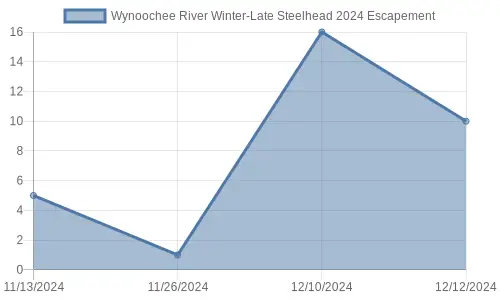
In good years, you will see numbers of hatchery steelhead start to show in November!

The Satsop River has a smaller hatchery return, however, given its location entering the Chehalis River below the Skookumchuck there are still good numbers of hatchery steelhead navigating this stretch of river that you can intercept.
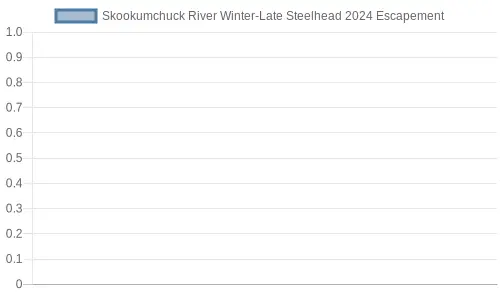
Generally speaking, fishing below the Skookumchuck River provides a greater number of hatchery steelhead to encounter.
When to fish for winter steelhead on the Chehalis River?
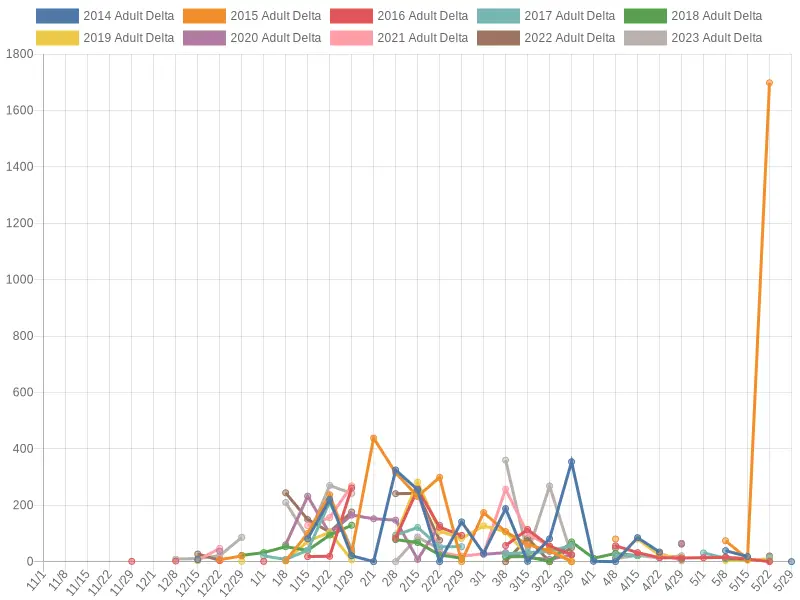
Fishing the Wynoochee in January-February can provide excellent opportunities to encounter hatcher steelhead.

The hatchery return on the Satsop is generally timed later and is a smaller run of steelhead, but that should also translate to fewer people fishing it, which may be attractive to some anglers.
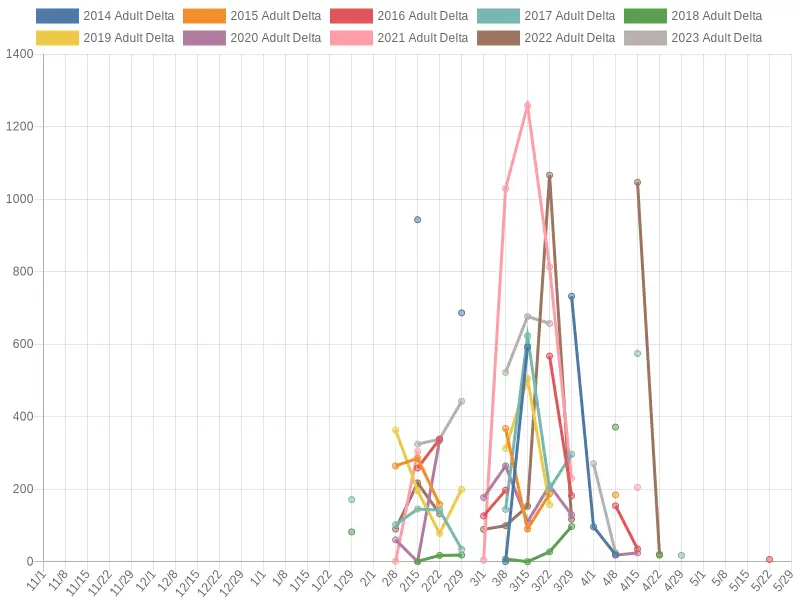
The Skookumchuck usually has a massive surge of steelhead in March, but in the 2024-2025 season, the river is expected to close on March 1st. Scroll down to the regulations section below to see the regulations and a link to the official WDFW announcement.
Before you ever go fishing on any river in Washington State make sure you know the regulations determining when a river is open, what part of the river, what gear you can use, and what fish can be retained.
WDFW Permanent Regulations can be found at this link, and we (PNWBestLife) “attempt” to make sure the table at the bottom of this page is also updated with the current permanent regulations.
You also must check the emergency regulations in case there are any changes to the permanent regulations.
Forecast for the 2024-2025 winter steelhead fishing season on the Chehalis River
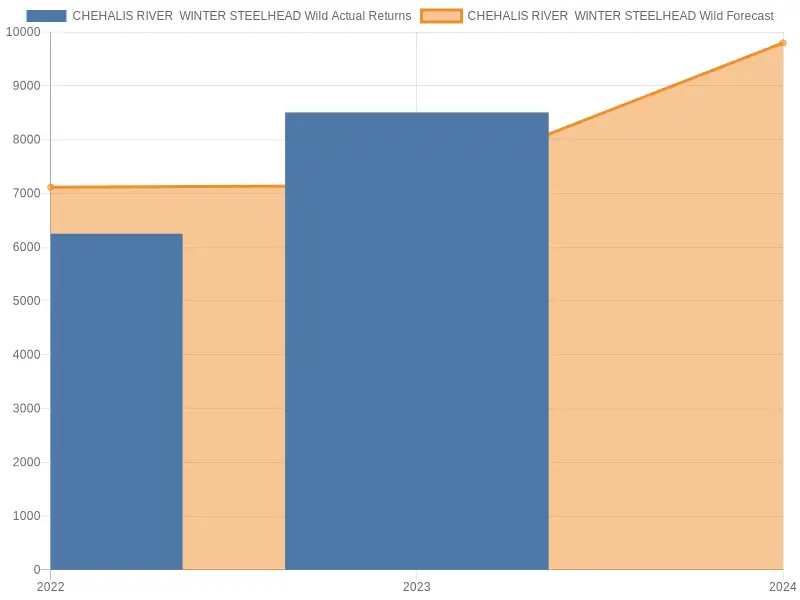
The above is where we are in terms of the expectation of returning wild steelhead and showing that the 2023-2024 return exceeded expectations. The above graph is why there’s a season planned for hatchery steelhead in the 2024-2025 return year.

The smolt plant trend remains positive for the entire Chehalis River system, which is great news for steelhead anglers in 2024-2025. Smolts released in 2023 will return as 3-year adults in the 2024-2025 season and make up the bulk of the run with steelhead weighing between 5-10 lbs typically.
Fishing Regulations on the Chehalis River for 2025-2026
| Species | Date | Additional Rules |
from the mouth (Hwy. 101 Bridge in Aberdeen) to Fuller Bridge (Keys Rd.) including all channels, sloughs, and interconnected waterways CRC (317) |
||
All species |
Aug. 1-Nov. 30 |
Single-point barbless hooks required. |
Aug. 1-Dec. 31 |
Two-Pole allowed. |
|
Trout |
Sat. before Memorial Day-Apr. 15 |
Statewide min. size/daily limit. Except: cutthroat trout and wild rainbow trout: min. size 14”. |
Other game fish |
Sat. before Memorial Day-Apr. 15 |
Statewide min. size/daily limit. |
Salmon |
Aug. 1-Sept. 15 |
Min. size 12”. Daily limit 6. Release adults. |
Sept. 16-Oct. 31 |
Min. size 12”. Daily limit 6 including no more than 2 adults. Release adult Chinook. |
|
Nov. 1-Dec. 31 |
Min. size 12”. Daily limit 6 including no more than 1 adult. Release Chinook. |
|
from Fuller Bridge (Keys Rd.) to South Elma Bridge (Wakefield Rd.) CRC (317) |
||
All species |
Aug. 1-Nov. 30 |
Single-point barbless hooks required. |
Aug. 1-Dec. 31 |
Two-Pole allowed. |
|
Aug. 1-Sept. 15 |
Bait prohibited. |
|
Trout |
Sat. before Memorial Day-Apr. 15 |
Statewide min. size/daily limit. Except: cutthroat trout and wild rainbow trout: min. size 14”. |
Other game fish |
Sat. before Memorial Day-Apr. 15 |
Statewide min. size/daily limit. |
Salmon |
Aug. 1-Sept. 15 |
Min. size 12”. Daily limit 6. Release adults. |
Sept. 16-Sept. 30 |
Closed. |
|
Oct. 1-Oct. 31 |
Min. size 12”. Daily limit 6 including no more than 2 adults. Release adult Chinook. |
|
Nov. 1-Dec. 31 |
Min. size 12”. Daily limit 6 including no more than 1 adult. Release Chinook. |
|
from South Elma Bridge (Wakefield Rd.) to the Black River CRC (317) |
||
All species |
Aug. 1-Nov. 30 |
Single-point barbless hooks required. |
Trout |
Sat. before Memorial Day-Apr. 15 |
Statewide min. size/daily limit. Except: cutthroat trout and wild rainbow trout: min. size 14”. |
Other game fish |
Sat. before Memorial Day-Apr. 15 |
Statewide min. size/daily limit. |
Salmon |
Oct. 1-Oct. 31 |
Min. size 12”. Daily limit 6 including no more than 2 adults. Release adult Chinook. |
Nov. 1-Dec. 31 |
Min. size 12”. Daily limit 6 including no more than 1 adult. Release Chinook. |
|
from the Black River to the high bridge on Weyerhaeuser 1000 line CRC (315) |
||
All species |
Aug. 16-Nov. 30 |
Single-point barbless hooks required. |
Trout |
Sat. before Memorial Day-Apr. 15 |
Statewide min. size/daily limit. Except: cutthroat trout and wild rainbow trout: min. size 14”. |
Other game fish |
Sat. before Memorial Day-Apr. 15 |
Statewide min. size/daily limit. |
Salmon |
Oct. 1-Oct. 31 |
Min. size 12”. Daily limit 6 including no more than 2 adults. Release adult Chinook. |
Nov. 1-Dec. 31 |
Min. size 12”. Daily limit 6 including no more than 1 adult. Release Chinook. |
|
from high bridge on Weyerhaeuser 1000 line approx. 400 yards downstream of Roger Creek (south of Pe Ell) upstream including all forks CRC (315) |
||
All species |
Selective gear rules. |
|
Trout |
Sat. before Memorial Day-Apr. 15 |
Statewide min. size/daily limit. Except: release cutthroat trout and wild rainbow trout. |
Other game fish |
Sat. before Memorial Day-Apr. 15 |
Statewide min. size/daily limit. |
Here’s the text of the special rule change as part of the 2024-2025 Washington Coast steelhead season being announced:
Selective gear rules (no bait) and a single-point barbless hook are required this season for coastal steelhead rivers including those in Willapa Bay, Grays Harbor, and along the mid- and northern coasts. The daily bag limit for all rivers and streams is two hatchery steelhead, and anglers must release wild steelhead and rainbow trout. Anglers may not remove wild steelhead fully from the water prior to release.
Additional emergency fishing rule changes could occur throughout the season. Fisheries in April are currently unlikely but are contingent on in-season updates and discussions with co-managers.
The areas listed below are open Dec. 2, 2024 through March 31, 2025 unless noted otherwise.
Chehalis River and all forks (Grays Harbor Co.). Closes March 1.
WDFW Washington Coast 2024-2025 Winter Steelhead Season
You should always check WDFW’s Emergency Rules page before you go to ensure you have the latest information about what the regulations are.
It’s your responsibility as the recreational angler to know ALL of these rules, not just what is discussed here on the blog.